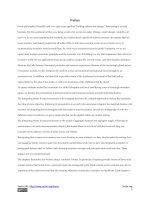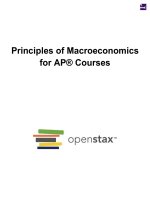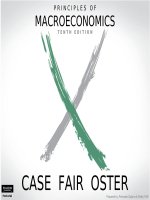Principles of macroeconomics 10e by case fair oster ch20
Bạn đang xem bản rút gọn của tài liệu. Xem và tải ngay bản đầy đủ của tài liệu tại đây (1.03 MB, 58 trang )
PRINCIPLES OF
MACROECONOMICS
PART V The World Economy
TENTH
EDITION
CASE FAIR OSTER
© 2012 Pearson Education, Inc. Publishing as Prentice Hall
Prepared by: Fernando Quijano & Shelly
1 ofTefft
58
PART V The World Economy
© 2012 Pearson Education, Inc. Publishing as Prentice Hall
2 of 58
Open-Economy
Macroeconomics:
The Balance of
Payments and
Exchange Rates
20
CHAPTER OUTLINE
The Balance of Payments
The Current Account
The Capital Account
The United States as a Debtor Nation
Equilibrium Output (Income) in an Open Economy
The International Sector and Planned Aggregate Expenditure
Imports and Exports and the Trade Feedback Effect
Import and Export Prices and the Price Feedback Effect
PART V The World Economy
The Open Economy with Flexible Exchange Rates
© 2012 Pearson Education, Inc. Publishing as Prentice Hall
The Market for Foreign Exchange
Factors That Affect Exchange Rates
The Effects of Exchange Rates on the Economy
An Interdependent World Economy
Appendix: World Monetary Systems Since 1900
3 of 58
When people in countries with different currencies buy from and sell
to each other, an exchange of currencies must also take place.
PART V The World Economy
exchange rate The price of one country’s currency
in terms of another country’s currency; the ratio at
which two currencies are traded for each other.
Within a certain range of exchange rates, trade flows in both
directions, is mutually beneficial, and each country specializes in
producing the goods in which it enjoys a comparative advantage.
In 1971, most countries, including the United States, began allowing
exchange rates to be determined essentially by supply and demand.
© 2012 Pearson Education, Inc. Publishing as Prentice Hall
4 of 58
PART V The World Economy
The study of exchange rates is very important because:
a.
Exchange rates determine the course of monetary policy.
b.
Exchange rates strongly influence interest rates.
c.
Exchange rates are a factor in determining the flow of
international trade.
d.
All of the above.
© 2012 Pearson Education, Inc. Publishing as Prentice Hall
5 of 58
PART V The World Economy
The study of exchange rates is very important because:
a.
Exchange rates determine the course of monetary policy.
b.
Exchange rates strongly influence interest rates.
c.
Exchange rates are a factor in determining the flow of
international trade.
d.
All of the above.
© 2012 Pearson Education, Inc. Publishing as Prentice Hall
6 of 58
The Balance of Payments
PART V The World Economy
foreign exchange All currencies other than the
domestic currency of a given country.
balance of payments The record of a country’s
transactions in goods, services, and assets with the
rest of the world; also the record of a country’s sources
(supply) and uses (demand) of foreign exchange.
© 2012 Pearson Education, Inc. Publishing as Prentice Hall
7 of 58
PART V The World Economy
Colombian purchases of real estate in Miami:
a.
Increase the U.S. supply of foreign exchange.
b.
Increase the U.S. demand for foreign exchange.
c.
Decrease the U.S. supply of foreign exchange.
d.
Decrease the U.S. demand for foreign exchange.
© 2012 Pearson Education, Inc. Publishing as Prentice Hall
8 of 58
PART V The World Economy
Colombian purchases of real estate in Miami:
a.
Increase the U.S. supply of foreign exchange.
b.
Increase the U.S. demand for foreign exchange.
c.
Decrease the U.S. supply of foreign exchange.
d.
Decrease the U.S. demand for foreign exchange.
© 2012 Pearson Education, Inc. Publishing as Prentice Hall
9 of 58
The Balance of Payments
The Current Account
balance of trade A country’s exports of goods and services minus
its imports of goods and services.
trade deficit Occurs when a country’s exports of goods and
services are less than its imports of goods and services.
balance on current account Net exports of goods plus net exports
of services plus net investment income plus net transfer payments.
PART V The World Economy
The Capital Account
balance on capital account In the United States, the sum of the
following (measured in a given period): the change in private U.S.
assets abroad, the change in foreign private assets in the United
States, the change in U.S. government assets abroad, and the
change in foreign government assets in the United States.
© 2012 Pearson Education, Inc. Publishing as Prentice Hall
10 of 58
TABLE 20.1 United States Balance of Payments, 2009
All transactions that bring foreign exchange into the United States are credited (+) to the current
account; all transactions that cause the United States to lose foreign exchange are debited (−) to
the current account
PART V The World Economy
Current Account
Goods exports
Goods imports
(1) Net export of goods
Billions of dollars
1,045.5
–1,562.6
–517.1
Exports of services
Imports of services
(2) Net export of services
509.2
–370.8
138.4
Income received on investments
Income payments on investments
561.2
–472.2
(3) Net investment income
(4) Net transfer payments
(5) Balance on current account (1 + 2 + 3 + 4)
Capital Account
(6) Change in private U.S. assets abroad (increase is –)
(7) Change in foreign private assets in the United States
(8) Change in U.S. government assets abroad (increase is –)
89.0
–130.2
–419.9
(9) Change in foreign government assets in the United States
(10) Balance on capital account (6 + 7 + 8 + 9)
447.6
(11) Net capital account transactions
(12) Statistical discrepancy
(13) Balance of payments (5 + 10 + 11 + 12)
© 2012 Pearson Education, Inc. Publishing as Prentice Hall
–727.0
–12.3
489.6
197.9
–2.9
224.9
0
11 of 58
The Balance of Payments
The United States as a Debtor Nation
Prior to the mid-1970s, the United States had generally run current
account surpluses, and thus its net wealth position was positive. It was
a creditor nation.
Sometime between the mid-1970s and the mid-1980s, the United
States reversed its net wealth position vis-à-vis the rest of the world,
and was running large current account deficits.
PART V The World Economy
Now it is the largest debtor nation in the world.
This reflects the fact that for the past three decades, it has spent much
more on foreign goods and services than it has earned through the
sales of its goods and services to the rest of the world.
© 2012 Pearson Education, Inc. Publishing as Prentice Hall
12 of 58
PART V The World Economy
When a nation has spent more on foreign goods and services than it
has earned through the sales of its goods and services to the rest of the
world, its net wealth position vis-à-vis the rest of the world must have:
a.
Increased.
b.
Decreased.
c.
Remained the same.
d.
Either increased or decreased, depending on changes in the
capital account.
© 2012 Pearson Education, Inc. Publishing as Prentice Hall
13 of 58
PART V The World Economy
When a nation has spent more on foreign goods and services than it
has earned through the sales of its goods and services to the rest of the
world, its net wealth position vis-à-vis the rest of the world must have:
a.
Increased.
b.
Decreased.
c.
Remained the same.
d.
Either increased or decreased, depending on changes in the
capital account.
© 2012 Pearson Education, Inc. Publishing as Prentice Hall
14 of 58
PART V The World Economy
If the balance on capital account is positive, the net wealth position of a
country has:
a.
Increased.
b.
Decreased.
c.
Remained the same.
d.
Either increased or decreased, depending on other changes in
the balance of payments account.
© 2012 Pearson Education, Inc. Publishing as Prentice Hall
15 of 58
PART V The World Economy
If the balance on capital account is positive, the net wealth position of a
country has:
a.
Increased.
b.
Decreased.
c.
Remained the same.
d.
Either increased or decreased, depending on other changes in
the balance of payments account.
© 2012 Pearson Education, Inc. Publishing as Prentice Hall
16 of 58
E C O N O M I C S I N PRACTI C E
The Composition of Trade Gaps
PART V The World Economy
Trade gaps, or deficits, occur
when a country’s imports of
goods and services outweigh
its exports.
These trade gaps can change
because an entrepreneur from
one country invents and
produces something that
generates big sales abroad or
because imports from one
country have a big price
change.
France’s trade deficit narrowed as the price of importing oil shrunk while sales
of one of its export goods—the Airbus—grew.
French Trade Gap Narrowed Sharply in 2009
The Wall Street Journal
© 2012 Pearson Education, Inc. Publishing as Prentice Hall
17 of 58
Equilibrium Output (Income) in an Open Economy
The International Sector and Planned Aggregate Expenditure
Planned aggregate expenditure in an open economy:
AE ≡ C + I + G + EX − IM
net exports of goods and services (EX − IM) The
difference between a country’s total exports and total imports.
Determining the Level of Imports
PART V The World Economy
When income rises, imports tend to go up. Algebraically,
IM = mY
where Y is income and m is some positive number.
marginal propensity to import (MPM) The change in
imports caused by a $1 change in income.
© 2012 Pearson Education, Inc. Publishing as Prentice Hall
18 of 58
Equilibrium Output (Income) in an Open Economy
The International Sector and Planned Aggregate Expenditure
PART V The World Economy
Solving for Equilibrium
FIGURE 20.1 Determining Equilibrium Output in an Open Economy
In a., planned investment spending (I), government spending (G), and total exports (EX) are added to consumption
(C) to arrive at planned aggregate expenditure. However, C + I + G + EX includes spending on imports.
In b., the amount imported at every level of income is subtracted from planned aggregate expenditure. Equilibrium
output occurs at Y* = 200, the point at which planned domestic aggregate expenditure crosses the 45-degree line.
© 2012 Pearson Education, Inc. Publishing as Prentice Hall
19 of 58
Equilibrium Output (Income) in an Open Economy
The International Sector and Planned Aggregate Expenditure
The Open-Economy Multiplier
open - economy multiplier =
1
1 − ( MPC − MPM )
PART V The World Economy
The effect of a sustained increase in government spending
(or investment) on income—that is, the multiplier—is smaller
in an open economy than in a closed economy.
The reason: When government spending (or investment)
increases and income and consumption rise, some of the
extra consumption spending that results is on foreign
products and not on domestically produced goods and
services.
© 2012 Pearson Education, Inc. Publishing as Prentice Hall
20 of 58
PART V The World Economy
The open-economy multiplier is:
a.
Larger than the closed-economy multiplier.
b.
Smaller than the closed-economy multiplier.
c.
The same as the closed-economy multiplier.
d.
Zero because imports and exports cancel each other out.
© 2012 Pearson Education, Inc. Publishing as Prentice Hall
21 of 58
PART V The World Economy
The open-economy multiplier is:
a.
Larger than the closed-economy multiplier.
b. Smaller than the closed-economy multiplier.
c.
The same as the closed-economy multiplier.
d.
Zero because imports and exports cancel each other out.
© 2012 Pearson Education, Inc. Publishing as Prentice Hall
22 of 58
Equilibrium Output (Income) in an Open Economy
Imports and Exports and the Trade Feedback Effect
The Determinants of Imports
The same factors that affect households’ consumption
behavior and firms’ investment behavior are likely to affect
the demand for imports.
The relative prices of domestically produced and foreignproduced goods also determine spending on imports.
PART V The World Economy
The Determinants of Exports
The demand for U.S. exports depends on economic activity
in the rest of the world as well as on the prices of U.S. goods
relative to the price of rest-of-the-world goods.
When foreign output increases, U.S. exports tend to
increase. U.S. exports also tend to increase when U.S. prices
fall relative to those in the rest of the world.
© 2012 Pearson Education, Inc. Publishing as Prentice Hall
23 of 58
Equilibrium Output (Income) in an Open Economy
Imports and Exports and the Trade Feedback Effect
The Trade Feedback Effect
PART V The World Economy
trade feedback effect The tendency for an
increase in the economic activity of one country
to lead to a worldwide increase in economic
activity, which then feeds back to that country.
An increase in U.S. imports increases other countries’
exports, which stimulates those countries’ economies and
increases their imports, which increases U.S. exports, which
stimulates the U.S. economy and increases its imports, and
so on. This is the trade feedback effect.
In other words, an increase in U.S. economic activity leads to
a worldwide increase in economic activity, which then “feeds
back” to the United States.
© 2012 Pearson Education, Inc. Publishing as Prentice Hall
24 of 58
E C O N O M I C S I N PRACTI C E
The Recession Takes Its Toll on Trade
PART V The World Economy
During recessions, people in
many countries become
more protectionist and seek
to protect jobs in their own
home industries by limiting
imports.
The figure below shows the
rise in trade levels in the
world over the period 2005
to the middle of 2008
followed by large declines in
the 2008–2009 recession.
© 2012 Pearson Education, Inc. Publishing as Prentice Hall
25 of 58









